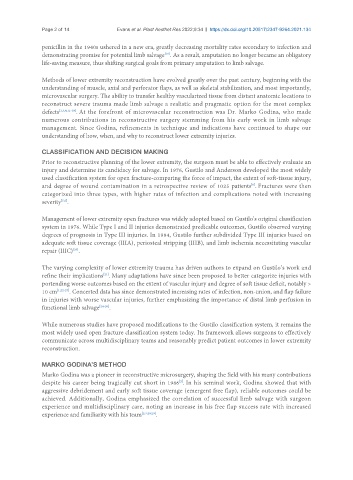Page 99 - Read Online
P. 99
Page 2 of 14 Evans et al. Plast Aesthet Res 2022;9:34 https://dx.doi.org/10.20517/2347-9264.2021.134
penicillin in the 1940s ushered in a new era, greatly decreasing mortality rates secondary to infection and
[10]
demonstrating promise for potential limb salvage . As a result, amputation no longer became an obligatory
life-saving measure, thus shifting surgical goals from primary amputation to limb salvage.
Methods of lower extremity reconstruction have evolved greatly over the past century, beginning with the
understanding of muscle, axial and perforator flaps, as well as skeletal stabilization, and most importantly,
microvascular surgery. The ability to transfer healthy vascularized tissue from distant anatomic locations to
reconstruct severe trauma made limb salvage a realistic and pragmatic option for the most complex
defects [1,3,4,11-19] . At the forefront of microvascular reconstruction was Dr. Marko Godina, who made
numerous contributions in reconstructive surgery stemming from his early work in limb salvage
management. Since Godina, refinements in technique and indications have continued to shape our
understanding of how, when, and why to reconstruct lower extremity injuries.
CLASSIFICATION AND DECISION MAKING
Prior to reconstructive planning of the lower extremity, the surgeon must be able to effectively evaluate an
injury and determine its candidacy for salvage. In 1976, Gustilo and Anderson developed the most widely
used classification system for open fracture-comparing the force of impact, the extent of soft-tissue injury,
and degree of wound contamination in a retrospective review of 1025 patients . Fractures were then
[6]
categorized into three types, with higher rates of infection and complications noted with increasing
severity .
[5,6]
Management of lower extremity open fractures was widely adopted based on Gustilo’s original classification
system in 1976. While Type I and II injuries demonstrated predicable outcomes, Gustilo observed varying
degrees of prognosis in Type III injuries. In 1984, Gustilo further subdivided Type III injuries based on
adequate soft tissue coverage (IIIA), periosteal stripping (IIIB), and limb ischemia necessitating vascular
[20]
repair (IIIC) .
The varying complexity of lower extremity trauma has driven authors to expand on Gustilo’s work and
refine their implications . Many adaptations have since been proposed to better categorize injuries with
[21]
portending worse outcomes based on the extent of vascular injury and degree of soft tissue deficit, notably >
10 cm [1,22-27] . Concerted data has since demonstrated increasing rates of infection, non-union, and flap failure
in injuries with worse vascular injuries, further emphasizing the importance of distal limb perfusion in
functional limb salvage [24-26] .
While numerous studies have proposed modifications to the Gustilo classification system, it remains the
most widely used open fracture classification system today. Its framework allows surgeons to effectively
communicate across multidisciplinary teams and reasonably predict patient outcomes in lower extremity
reconstruction.
MARKO GODINA’S METHOD
Marko Godina was a pioneer in reconstructive microsurgery, shaping the field with his many contributions
despite his career being tragically cut short in 1986 . In his seminal work, Godina showed that with
[2]
aggressive debridement and early soft tissue coverage (emergent free flap), reliable outcomes could be
achieved. Additionally, Godina emphasized the correlation of successful limb salvage with surgeon
experience and multidisciplinary care, noting an increase in his free flap success rate with increased
experience and familiarity with his team [2,3,28,29] .

